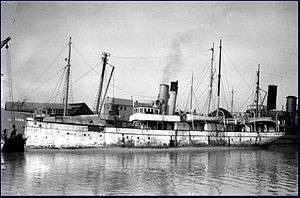HMCS Gulnare
 The former HMCS Gulnare (front) and the former HMCS Loos (rear) on 20 September 1937. | |
| History | |
|---|---|
| Name: | Gulnare |
| Launched: | 1893 |
| Acquired: | 1902 |
| Commissioned: | 1914 |
| Decommissioned: | 1918-1919 |
| Fate: | Broken up, 1946 or 1949 |
| General characteristics | |
| Displacement: | 262 tons |
| Length: | 137 ft (42 m) |
| Beam: | 20.5 ft (6.2 m) |
| Draught: | 14 ft (4.3 m) |
| Speed: | 10 kn (19 km/h; 12 mph) |
| Complement: | 25 |
HMCS Gulnare was a Canadian government ship that served as a patrol boat and guard vessel for the Royal Canadian Navy (RCN) during the First World War.
Origins and early years
Gulnare was a steel trawler type vessel, originally used by the British Admiralty for survey work in Newfoundland waters. Acquired by Canada in 1902 Gulnare was refitted and was used for tidal and current survey work on the East Coast, as well as on the lower Saint Lawrence River. As one of the ships in the Canadian Hydrographic Survey, she was transferred from the Department of Marine and Fisheries to the Department of Naval Service when the latter was created in 1910. In 1912, she was transferred from survey work to duties as a tender and relief lightship in the lower Saint Lawrence.[1][2]
First World War
Gulnare was placed under naval control in 1914.[3] She spent at least part of the war in Halifax, and was serving as a guard vessel for Bedford Basin at the time of the Halifax Explosion, but suffered minimal damage.[4] One researcher has postulated that Gulnare might be the ship in the foreground of a well-known photograph of the explosion's pyrocumulus cloud.[5]
Postwar
Gulnare was used for contraband patrols in 1918 and 1919 before being returned to the Department of Marine and Fisheries in 1920. Sources disagree about the details of her postwar career, although they do agree that she served as a tender and lightship, and was also used for tidal surveys and other work. According to one source, she was used for tidal survey work between 1931 and 1936, but was sold in 1937 because she was unsuited for this work in the more open waters of the lower Saint Lawrence. Gulnare may have been used by the RCN during the Second World War, and was scrapped in 1946 or 1949.[6][7][8]
References
- ↑ O.M. Meehan, "The Hydrographic Survey of Canada from its Formation to the First World War 1904-1914", The Northern Mariner/Le Marin du nord, XIV, No. 1 (January 2004), 53-54.
- ↑ O.M. Meehan, "The Hydrographic Survey of Canada from the First World War to the Commencement of the Canadian Hydrographic Service, 1915-1927", The Northern Mariner/Le Marin du nord, XIV, No. 1 (January 2004), 143-144.
- ↑ Charles D. Maginley and Bernard Collin, The Ships of Canada's Marine Services, St. Catharines, Ontario: Vanwell Publishing, 2001, p. 87.
- ↑ Ships of the Halifax Explosion
- ↑ Joel Zemel, "The Anatomy Of A Disaster: An Analysis of Two 1917 Halifax Explosion Blast Cloud Photographs"
- ↑ Charles D. Maginley and Bernard Collin, The Ships of Canada's Marine Services, St. Catharines, Ontario: Vanwell Publishing, 2001, p. 87.
- ↑ O.M. Meehan, "The Hydrographic Survey of Canada from the First World War to the Commencement of the Canadian Hydrographic Service, 1915-1927", The Northern Mariner/Le Marin du nord, XIV, No. 1 (January 2004), 143.
- ↑ O.M. Meehan, "The Hydrographie Survey of Canada from 1928 to the Commencement of the Second World War", The Northern Mariner/Le Marin du nord, XIV, No. 2 (April 2004), 160, 174, 181, 207, 210, 212, 214, 221.
External links
- Converted civilian vessels
- Canadian Navy Heritage Project: Ship Technical Information
- Canadian Navy Heritage Project: Photo Archive